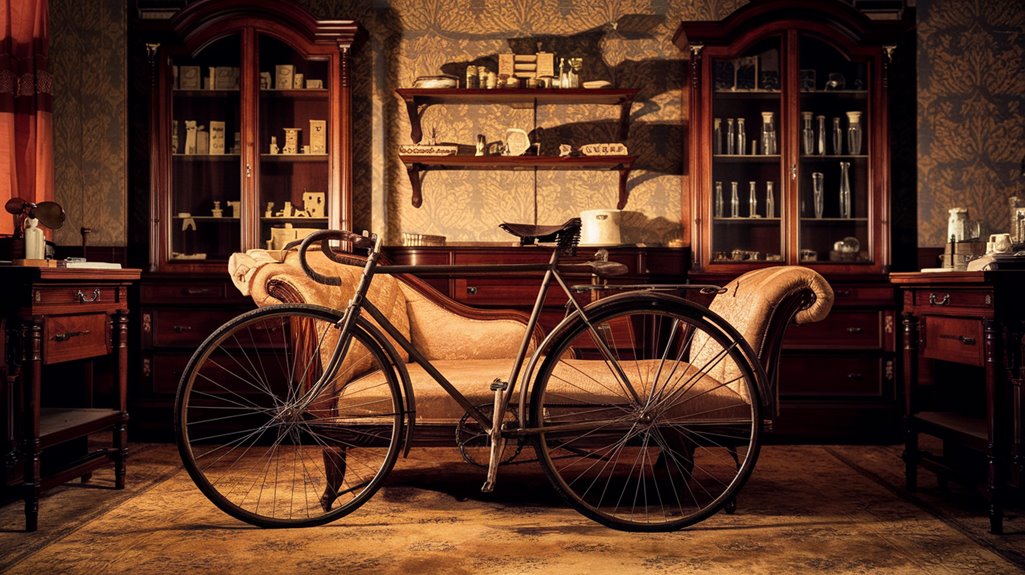Victorian Doctors Warned of “Bicycle Face” in Women Cyclists
Like Eve reaching for forbidden knowledge, you'll find Victorian women faced dire warnings when they dared to mount a bicycle. You've probably never worried that riding a bike would leave you with a permanently contorted face, but that's exactly what respected doctors claimed would happen to female cyclists in the 1890s. The bizarre diagnosis of "bicycle face" wasn't just about medical concerns—it revealed deep-seated anxieties about women's growing independence and mobility in society.
The Medical Mystery of Bicycle Face

During the late 19th century's cycling boom, a peculiar medical condition called "bicycle face" emerged as doctors claimed women cyclists suffered from permanent facial disfigurement.
Dr. Arthur Shadwell, a fierce anti-cyclist in Britain, first diagnosed this supposed affliction, sparking widespread cycling paranoia among Victorian society.
You'd recognize a "bicycle face" by its distinctive features: a flushed or pale complexion, drawn lips, and dark shadows under bulging eyes.
The condition supposedly stemmed from the strain of maintaining balance while cycling upright. Critics warned that these changes to women's bicycle aesthetics would damage their marriage prospects.
Despite these claims, pro-cycling advocates fought back, asserting that moderate cycling was perfectly healthy. Medical professionals claimed cycling would lead to infertility and tuberculosis in women riders.
As bicycles became more common, the hysteria around "bicycle face" eventually faded, though it remains a telling example of Victorian-era attempts to control women's behavior. The medical community often used these fears to encourage women to seek physician consultations before taking up cycling.
Women's Health Concerns in Victorian Society
The "bicycle face" hysteria exemplified a broader pattern of Victorian society using medical claims to control women's behavior and bodies.
These health misconceptions positioned women as perpetually ill and inherently weaker versions of men, with even natural processes like menstruation used as evidence of their frailty.
Gender biases permeated Victorian medical literature, where doctors like Thomas Smith Clouston reinforced ideas that women's health limitations justified their social restrictions. Medical literature consistently portrayed women's bodies as being in a perpetual state of illness.
The era's double standards extended to sexual health, with women enduring harsh medical examinations and social consequences while men's behavior went unchecked. Victorian wives were forced to tolerate their husbands' marital infidelity without legal recourse for divorce.
You'll find these prejudices reflected in working conditions too, where women faced severe health risks in factories while receiving unequal pay until 1850.
Even physical activities faced scrutiny, with doctors questioning women's ability to engage in simple exercises like cycling.
The Rise of the New Woman and Two-Wheeled Freedom
While Victorian society fretted over "bicycle face," a revolution was quietly taking shape on two wheels. The bicycle became more than just a mode of transportation – it transformed into a powerful symbol of women's liberation.
You would've seen pioneering cyclists like Frances Willard and Annie Londonderry challenging social norms, while the iconic "Gibson Girl" made cycling fashionable for women everywhere. Women adopted tailored A-line skirts that provided greater freedom of movement while cycling. Growing enthusiasm for cycling led to the creation of women's cycling clubs where female riders could support one another.
The "new woman" emerged through cycling clubs and social gatherings, finding unprecedented freedom beyond domestic confines. Despite concerns from traditional families who worried cycling would derail marriage prospects, women embraced their newfound mobility.
Publications like Ladies' World supported this cultural shift, offering practical advice for female cyclists. Susan B. Anthony captured this transformation perfectly when she declared that the bicycle did more to emancipate women than any other force.
Medical Debates and Social Control
As women pedaled their way to independence, medical professionals mounted a systematic campaign to discourage their cycling pursuits. They wielded medical authority to warn of dire consequences, from physical deformities to mental disorders, particularly targeting women's reproductive health and beauty.
The infamous "bicycle face" diagnosis, coined by Dr. A. Shadwell in the 1890s, exemplified how medical discourse was manipulated to reinforce gender stereotypes. You'd be told that cycling could lead to facial distortion, nervous conditions, and even complications during pregnancy.
These unfounded claims weren't really about health – they reflected society's resistance to women's growing mobility and independence. Medical professionals recommended "moderation" in cycling, effectively using health concerns as a tool to maintain social control over women's bodies and behaviors. Challenging prevailing notions, women defied these restrictions by promoting cycling as liberation, with many adopting innovative cycling attire that enabled more comfortable riding.
From Fear to Liberation: The Cultural Impact of Women Cyclists

Despite early medical fearmongering, cycling emerged as a powerful catalyst for women's liberation in the 1890s. You'll find that as women took to their bicycles, they sparked unprecedented societal transformation, challenging traditional gender roles and racial barriers.
Cycling empowerment came in many forms. Women like Annie Londonderry and Kittie Knox defied expectations, with Knox particularly breaking through both racial and gender restrictions in cycling clubs.
You can trace how this movement revolutionized women's fashion, as riders adopted practical clothing that prioritized function over Victorian modesty standards. The transition to bloomers for racing was pioneered by trailblazers like Cissie Colreavy in Australia.
Through cycling communities and organizations, women created their own spaces, wrote their own rules, and established their own competitions.
This grassroots movement didn't just change transportation – it fundamentally altered how society viewed women's capabilities, independence, and right to public space.










